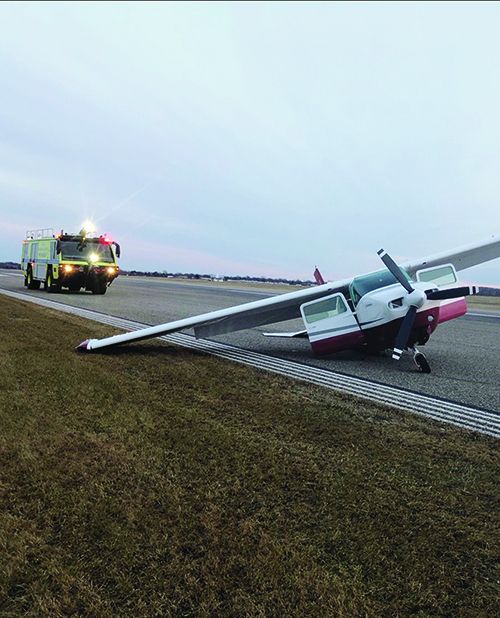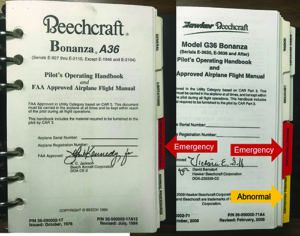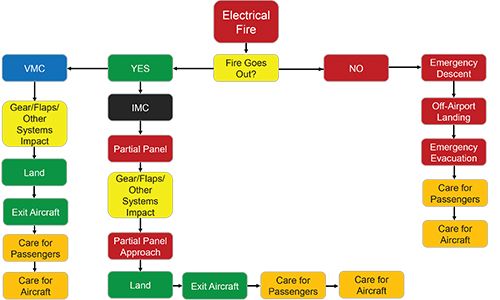
I learned a lot about flying airplanes while working 60 feet underground. I served as a missile launch control officer in the U.S. Air Force in the waning days of the Cold War. We worked in two-person crews, a commander and a deputy, behind a sealed blast door in a small room filled with old-school electronics that ran hot. A huge, forced air cooling system did its best to control the heat. But the possibility of fire in that confined space was always there, either from the electronics themselves, malfunction of the air conditioning unit that cooled them, or other scenarios. Consequently we learned to recognize overheats and potential overheats very rapidly, and were trained to follow practiced emergency procedures swiftly and correctly while using detailed emergency procedures checklists (“EPs”).
One of the key elements of our monthly training in a Missiles Procedures Trainer simulator, and our so-called “annual” checkride evaluations (because of crew partner changes, crew upgrades and systems changes I had eight “annual” evaluations in my four years on launch crew), was to voice aloud when you detected an “entering argument”—a status change requiring the use of an EP. Once you and your crew partner called it aloud, for example, “Electrical Fire or Overheat,” your job was to make it to the bottom of the applicable checklist as quickly as possible. Stating the nature of the scenario verbally was designed primarily to communicate with your crew partner and get agreement on the status. But I found actually saying “Electrical Fire or Overheat” out loud had a noticeable additional benefit: it put me in the emergency mindset.
I use and teach this “say it out loud” technique in airplanes. I think it can make a difference.
AN EXAMPLE
By way of illustration, a recent Pilatus PC-12 accident may be helpful. The NTSB’s investigation is still in its preliminary stages, but what we know so far might suggest the benefits of entering the emergency mindset. On April 23, 2020, at about 1600 Central time, the airplane was substantially damaged when it landed short of the intended divert airport after losing engine power. The solo pilot received serious injuries.
While in cruise, the pilot told ATC that he was losing power and accepted vectors to a nearby airport. The pilot then reported engine power had stabilized and he wanted to return to Dallas-Fort Worth International Airport. A few moments later, the pilot again reported losing engine power and needed to go back to the divert airport. At that time, ATC advised that a different airport was closer and provided a heading. The pilot reported that he was going to perform a 360° turn to set up for a left base for the second divert airport, but the airplane impacted terrain in a muddy field short of the runway.
The PC-12’s pilot never formally declared an emergency. The controller coded the aircraft “EA” (for emergency aircraft) on his scope, as evidenced by several online videos of the ATC radar track. In effect, ATC declared an emergency for the pilot, and provided every service it would have provided had the pilot declared an emergency himself.
When power initially “rolled back” (the phrase the pilot used in the ATC recording), the pilot answered the inevitable “What are your intentions?” question by saying he wanted to land at an airport almost directly ahead of him. That’s the point when it might have made a difference had the pilot said aloud to himself, “I have an engine failure. I have an emergency.” Whether he formally declared such to ATC is beside the point; by saying this aloud, he could have put himself in the emergency mindset and committed to the goal of landing at the closest airport with whatever capability he had available.
Not having made this commitment, however, when power spooled back up (temporarily), he changed his mind and asked to go back across a densely populated area to his departure airport, a choice most likely made more for convenience than for dealing with the engine problem. Putting himself in the emergency mindset might have made it easier for the pilot to stick to the plan and land at his first available divert airport even after power temporarily returned.
The emergency mindset results from the realization and acknowledgment that there is a threat to your survival. Once you’ve come to that realization, your objective is to do whatever is necessary to get the airplane on the ground as safely as possible as soon as possible. If you are well-trained and current with the checklists, you’ll be so involved in following the proper procedure that you won’t be afraid. That’s a common comment among pilots who have survived emergencies: time slows down, training kicks in and, if they feel fear, it typically doesn’t happen until after the airplane has come to a stop on the ground and they’ve run out of things to do.

It’s a matter of constant debate: When should you declare an emergency? Realizing the emergency declaration is for you, and not necessarily for controllers, my feeling is that you should declare an emergency and enter the emergency mindset any time you are performing a procedure described in an Emergency Procedures checklist. That removes the ambiguity of declaring an emergency, and it puts you in the mode of working to get the aircraft safely on the ground as quickly as possible.
That said, most airplanes have a lot in the Emergency Procedures section that is not really a full-blown emergency. There is a second category of unusual situations that in larger airplanes is called Abnormal Procedures. The distinction is that an emergency is when there is an immediate threat to life and/or aircraft damage, while an abnormal condition is when you must operate differently than normal because of a system outage, one that left uncorrected may develop into an emergency.
To better understand this distinction, look at the differences between the Beech A36 and G36 Bonanza Pilot’s Operating Handbooks in the image above. The G36 POH is unusual for light airplanes in that it has a separate Abnormal Procedures section. Many of the checklists that are “emergencies” in the earlier A36 model are “abnormals” in the later G36. Checklists for less time-critical items like alternator failures or a forward cabin door opening in flight are “abnormal.”
To be sure, I’d classify some of what Beech calls “abnormal” as being an emergency, such as a rough-running engine, while some “emergencies” like electric pitch trim failure are really just abnormal conditions in my view. But hopefully you get the point: Look at the emergency checklists for the aircraft you fly and decide now, while you’re at zero altitude, zero airspeed and 1G, which you consider to be true “emergencies.” If in flight and you find yourself doing what any of those checklists call for, tell yourself, then tell ATC, that you have an emergency.
BENEFITS
Absolutely, there are benefits in declaring an emergency to ATC, which can be an amazing resource. Controllers typically will do just about anything for the pilot of an aircraft in distress. But what services are triggered by telling ATC, “I’m declaring an emergency?” This is addressed in Chapter 10 of FAA JO 7110.65Y, “Air Traffic Control,” the so-called controller’s bible containing primary operating guidelines. First, all those things we complain about controllers asking if the pilot declares an emergency? They’re right there in the very first paragraph of this section, designated as “information requirements.” The controller’s supposed to ask for the aircraft identification and type (although they may already know this and not need to inquire), nature of the emergency and the pilot’s intentions.
After this initial inquiry, there’s a whole list of items controllers are directed to ask to help them better support the emergency aircraft. These include altitude, fuel remaining (measured in time), number on board (“souls” in common parlance) and emergency equipment on board (life raft or personal flotation devices, for example, on an overwater flight). There’s also a slew of questions about position, airspeed, navigation capability, airplane color and other items that would be more applicable if the airplane was not participating in ATC services and made a pop-up emergency call.
What can ATC do with this information? Pretty much anything the pilot asks, including obtaining information, limiting frequency changes and clearing other airplanes out of the way. ATC does not have to wait for the pilot to declare an emergency to provide these services. Section 10-2-5 tells controllers to “consider that an aircraft emergency exists” when an emergency is declared by the pilot, by [ATC] facility personnel, or by “officials responsible for the operation of the aircraft.” By “facility personnel,” this means the controller can initiate emergency authority; in effect, declare an emergency for the pilot without the pilot’s request or even that pilot’s knowledge, if the controller feels it is warranted.
Section 10 goes on for several pages to describe controller actions to provide emergency assistance. A large part of this covers helping VFR-only pilots who encounter instrument meteorological conditions, as well as ELT activations, hijackings, bomb threats, unauthorized laser illumination of aircraft and even attacks by Man-Portable Air Defense Systems (shoulder-mounted rockets, and yes, that’s in there). The most interesting thing I as a pilot read in this document is that, assuming ATC is in radio contact with a pilot during the emergency, controllers have no additional authority to act after a pilot declares an emergency than they do before a pilot does so.
Declaring an emergency gets you ATC’s undivided attention, but it does not trigger a menu of ATC services that do not already exist for you otherwise. Giving an emergency aircraft airspace and landing priority over other aircraft isn’t even mentioned in the section on Emergency Assistance, although 2-1-4(a) succinctly states, “An aircraft in distress has the right of way over all other aircraft,” citing the familiar FAR 91.113(c).
It’s up to you, as pilot-in-command, to tell ATC what assistance you need and what you want to do—what are your intentions? It all comes back to your authority as PIC under FAR 91.3(b): “In an in-flight emergency requiring immediate action, the pilot in command may deviate from any rule in [Part 91] to the extent required to meet that emergency.”
You can (and should) be open to suggestions and avoid being so focused on one option that you fail to consider others. But ultimately in an emergency, you have to decide what to do. Getting into the emergency mindset, and committing yourself to get the aircraft safely on the ground at the earliest opportunity, is key to working with ATC to maximize your chances of survival.

In aviation, we tend to train and practice emergencies as isolated events. “You have an electrical fire” is followed by the Electrical Fire procedure. When you’re done with the checklist, you stop, turn everything back on and then move on to the next checklist.
Assume you detect and say, “I have an electrical fire emergency.” You’re now in the emergency mindset and set on a course of decisions and actions to get the airplane on the ground and people out of the aircraft. Your initial checklist actions will result in either the fire going out or the fire continuing. If the fire goes out, your response will be different in IMC than it is if you’re lucky enough to be in VMC and able to remain visual to the ground.
In VMC, you’ll assess any systems impact including the need to manual extend landing gear, land flaps up, and work with avionics and/or other systems outages. Any of these outages might drive the need to perform another checklist. You’ll land as soon as practicable, exit the airplane, see to any passenger needs and lastly make arrangements to care for the aircraft. If in IMC or if you need to enter IMC to land, you may be partial panel. Assess the system impact and prepare for an abnormal arrival (manually extend flaps and/or gear, no flap landing, etc.) and may need to fly a partial panel approach. Then land, exit the aircraft and care for passengers, then take care of the airplane.
If the fire does not go out your life is a lot more complicated. VMC or IMC, initiate an emergency descent, then transition to an off-airport landing (unless chance puts you right over an airport when this happens). As soon at the airplane comes to a stop oversee passenger evacuation. Then care for any injured passengers and handle the needs of everyone. Once that’s done—it may be days later—care for the aircraft, which in this context I’d include any telephone follow-up with ATC and filing the required NTSB Form 6120.1 – Pilot Operator Aircraft Accident/Incident Report.
My point is that when you say aloud, “I have an emergency,” you are setting off a series of checklists and procedures you’ll have to know and complete all the way until the airplane is on the ground and everyone is out of the aircraft. Each time you review and emergency procedure, ask yourself, “What comes next?” until everyone is out of the aircraft on the ground.
As the Greek poet Archilochus wrote over 2500 years ago, “We don’t rise to the level of our expectations; we fall to the level of our training.”
I DECLARE
Declaring an emergency, then, is more about you and setting the tone for what you’ll do next than it is to get anything more from ATC. The controllers are a vital resource to provide information like airport data, frequencies and weather updates when you may be too busy to look things up yourself. But the controller cannot troubleshoot your problem and cannot fly the airplane for you. Best outcomes result when you remain in charge and tell ATC what you need and what you want to do. Most of all, declaring an emergency puts you in the emergency mindset, and triggers your trained and practiced responses to the threats to your safety and that of your passengers.



